I love this pickup. Awesome peice of engineering
You are using an out of date browser. It may not display this or other websites correctly.
You should upgrade or use an alternative browser.
You should upgrade or use an alternative browser.

Help Support Prospecting Australia:
This site may earn a commission from merchant affiliate
links, including eBay, Amazon, and others.
G
Guest
Very impressive mate I do like the build. Thank you for posting. Would you mind if other members copied your design.
G
Guest
Two stroke pumps, how many people who run these little pumps gives a thought to which way the muffler is pointing while they are running it for banking? Why you may ask and I would say ever seen the oil slick on the water from where the muffler has been blowing the exhaust. Yes sir this has a chance of finding its way into your banker and zip gold gone in the blink of an eye. I use a small 2 stroke when working remote areas they do have a place in your prospecting arsenal.
For sure ive got a lotte 2 stroke spits oil. This liytle pump i run 3 meters of pickup to keep it well away from the water. Good tip
G
Guest
Small Engine maintenance all you need to know.
General info on 2 Strokes
Troubleshooting Tips
Ignition related problems
Fuel related problems
Compression related problems
Exhaust related problems
Timing related problems
Starting Tips
General info on 4 Strokes
Ignition related problems
Fuel related problems
Compression related problems
Timing related problems
Charging system
Starter problems
Advice about governors
Twin Cylinder Tips
Download Link
http://smallengineadvisor.com/memberdetails.htm
General info on 2 Strokes
Troubleshooting Tips
Ignition related problems
Fuel related problems
Compression related problems
Exhaust related problems
Timing related problems
Starting Tips
General info on 4 Strokes
Ignition related problems
Fuel related problems
Compression related problems
Timing related problems
Charging system
Starter problems
Advice about governors
Twin Cylinder Tips
Download Link
http://smallengineadvisor.com/memberdetails.htm
G
Guest
Spot on.


G
Guest
Distance Pumping and Banking
One of the very first points you will notice when you move water over a long distance is the fuel consumption of the pump motor. If your pump only has one inch ports, I am sorry to say it will not be good enough for the job. If you try this type of work with a little pump and motor such as the Honda WX10 or the small Chinese two strokes you will need a lot and I mean a lot of fuel. The poor little pumps work hard at distance, you will be forever walking back to them for refueling, it will drive you nuts. Anything say up to and over 80 meters is just too much for such pumps, you will find that they will burn out very quickly. I would only run them under 70 meters and then I would have to give it good thought before I did but that is me.
From the pump for the first 60 to 80 odd meters I run a two inch lay flat hose, stepped down into a 1 inch lay flat hose, if need be I can step down to a 1 inch lay flat if required for the last run. Let me explain why I run my hoses out in such a fashion. Friction loss is a real pain and it is quite evident over a long distance. The aim of this over bore in the lay flat is to make the lay flat into a manifold so that the spray bars are using way less volume of water than the length of lay flat is delivering to the unit this will make getting pressure at the spray bars much better, with a lot less fuel needed. Same style as how the old timers got pressure to the tip of their water monitors. If you were to run the whole length at one inch lay flat hose, you would find your jetting power is virtually nil to very poor and that is out of a bigger 2.2 1 pump under full throttle. If you ran 1 only that would work ok but your fuel usage goes through the roof by comparison. On my 2 inch lay flat hose I have fitted 1 inch polypropylene camlock fittings, I used to run the old polypropylene screw nut and tail joint but over the years the sand destroyed the threads they reached a stage where replacements were required. The camlock fittings are much easier to work with easy to use easier to joint your hose they are recommended. Even though the 2 inch hose is reduced at the joints it is the length that pays out in the reduction of friction loss. I run mostly 20 meter lengths rolled up on garden hose reels, with the odd 10 to 15 meter lengths for when I am just that little bit short on my chosen area. The pump I use is the Honda wx15 top little unit.
One of the very first points you will notice when you move water over a long distance is the fuel consumption of the pump motor. If your pump only has one inch ports, I am sorry to say it will not be good enough for the job. If you try this type of work with a little pump and motor such as the Honda WX10 or the small Chinese two strokes you will need a lot and I mean a lot of fuel. The poor little pumps work hard at distance, you will be forever walking back to them for refueling, it will drive you nuts. Anything say up to and over 80 meters is just too much for such pumps, you will find that they will burn out very quickly. I would only run them under 70 meters and then I would have to give it good thought before I did but that is me.
From the pump for the first 60 to 80 odd meters I run a two inch lay flat hose, stepped down into a 1 inch lay flat hose, if need be I can step down to a 1 inch lay flat if required for the last run. Let me explain why I run my hoses out in such a fashion. Friction loss is a real pain and it is quite evident over a long distance. The aim of this over bore in the lay flat is to make the lay flat into a manifold so that the spray bars are using way less volume of water than the length of lay flat is delivering to the unit this will make getting pressure at the spray bars much better, with a lot less fuel needed. Same style as how the old timers got pressure to the tip of their water monitors. If you were to run the whole length at one inch lay flat hose, you would find your jetting power is virtually nil to very poor and that is out of a bigger 2.2 1 pump under full throttle. If you ran 1 only that would work ok but your fuel usage goes through the roof by comparison. On my 2 inch lay flat hose I have fitted 1 inch polypropylene camlock fittings, I used to run the old polypropylene screw nut and tail joint but over the years the sand destroyed the threads they reached a stage where replacements were required. The camlock fittings are much easier to work with easy to use easier to joint your hose they are recommended. Even though the 2 inch hose is reduced at the joints it is the length that pays out in the reduction of friction loss. I run mostly 20 meter lengths rolled up on garden hose reels, with the odd 10 to 15 meter lengths for when I am just that little bit short on my chosen area. The pump I use is the Honda wx15 top little unit.
Did this at Tuena.
Had about a 15 meter lift as well.
The type of lay flat I was using is the type that Town Fire Brigades use.
It has a smooth bore rubber lining to cut down on friction.
Pump is a 1 1/2 Davey single impeller coupled to a Honda 5.5 Horse power motor.
Actually had too much pressure and when you are doing this sort of thing,
Be care full on how much you restrict your flow as back pressure will cause the pump to cavitate.
Oh, It did it well.


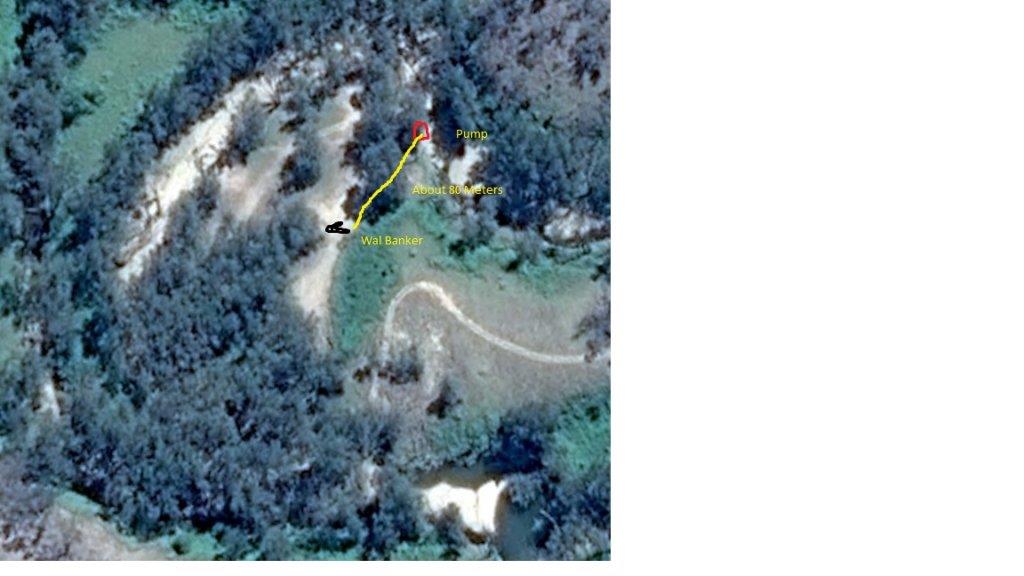
Had about a 15 meter lift as well.
The type of lay flat I was using is the type that Town Fire Brigades use.
It has a smooth bore rubber lining to cut down on friction.
Pump is a 1 1/2 Davey single impeller coupled to a Honda 5.5 Horse power motor.
Actually had too much pressure and when you are doing this sort of thing,
Be care full on how much you restrict your flow as back pressure will cause the pump to cavitate.
Oh, It did it well.

G
Guest
Yes you really got to watch for cavitation, and hammer lock. Hammer lock happens when people drive over your hose or the water is cut off then released suddenly while your pump is running under full steam.
G
Guest
You Only Get Back From What You Put Through.
These words were said by a person who really knew the game. The equipment you are using must have the ability to process large amounts of wash in any given day. To be able to be relocate with ease at any given time. The type of equipment that restricts you to one location without the scope of a larger working area in my view is not worth the money. As experience has shown over the years gold can disappear as quick as you found it. Hence the need for flexibility and mobility. Your pump must also be able to deliver all that is require of it, in other words be able to pump distance. Have enough pressure at distance to be able to work in clay conditions my advice to you would be if it cant get one that can. About one of the worst experiences you will encounter in wet water prospecting is when you find a top run of gold and your equipment is not good enough to work it, knowing on your next visit someone would have. You just hate that. So as stated if you want to get a lot of gold you have to work for it push the wash through and reap the returns, But make sure there is gold in the wash to start with no point working hard if there is no gold present.

These words were said by a person who really knew the game. The equipment you are using must have the ability to process large amounts of wash in any given day. To be able to be relocate with ease at any given time. The type of equipment that restricts you to one location without the scope of a larger working area in my view is not worth the money. As experience has shown over the years gold can disappear as quick as you found it. Hence the need for flexibility and mobility. Your pump must also be able to deliver all that is require of it, in other words be able to pump distance. Have enough pressure at distance to be able to work in clay conditions my advice to you would be if it cant get one that can. About one of the worst experiences you will encounter in wet water prospecting is when you find a top run of gold and your equipment is not good enough to work it, knowing on your next visit someone would have. You just hate that. So as stated if you want to get a lot of gold you have to work for it push the wash through and reap the returns, But make sure there is gold in the wash to start with no point working hard if there is no gold present.

G
Guest
Sieving into a banker.
Sieving great topic! unless you know how to gravitate the sieves than I recommend you dont use them! The reason been if there are any nuggets present among the gravels you will not see them sure you may flick through the gravel but you can and will miss them you must gravitate its the only way to be sure. As for sieving into a High Banker hmmmm I think it is a waste of time, let us look at the feed rate and see who would come out on top working average river or creek wash that is showing 20 colors per pan. Say it takes two minutes two sieve a shovel of wash into a bucket, a total of 5 shovels and the operator is looking at ten minutes pulse another 4 minutes to put it through the unit he is using. 14 minutes all up! Now I can put 10 shovels full of wash through my unit in two minutes 50 shovels in the same ten minute period with an extra 20 in the time the first guy is putting the concentrate through his unit.
Sure it may coast me an extra $1. 50 a day in fuel but anything over 40 meters away from your work face, you must work to your pumps speed. Which it needs to push the water anything under and I can drop the extra $1.50 my pump is strong enough to do it at idle. If the ground is rocky that I am working I take the time and rake and clear the larger rocks. For this job I use a 3 prong rake & a small pick. I first drag the pick through the sand loosening any larger rock embedded. I then run the rake over the area pulling all the rock back into the area I have already worked.
Remember all the post I do well, they are just my thoughts, and the advice I would give if asked.
Tools of the trade.
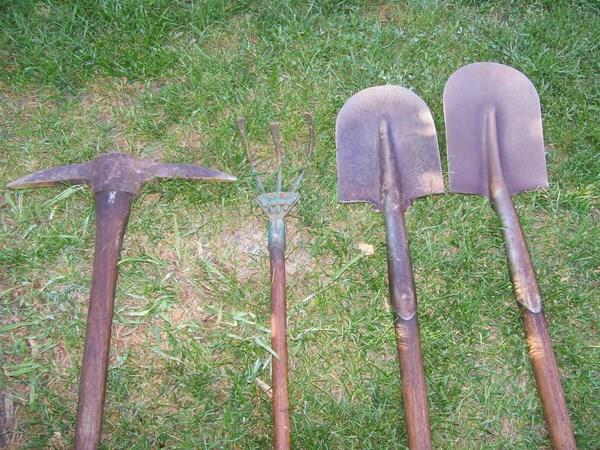
Sieving great topic! unless you know how to gravitate the sieves than I recommend you dont use them! The reason been if there are any nuggets present among the gravels you will not see them sure you may flick through the gravel but you can and will miss them you must gravitate its the only way to be sure. As for sieving into a High Banker hmmmm I think it is a waste of time, let us look at the feed rate and see who would come out on top working average river or creek wash that is showing 20 colors per pan. Say it takes two minutes two sieve a shovel of wash into a bucket, a total of 5 shovels and the operator is looking at ten minutes pulse another 4 minutes to put it through the unit he is using. 14 minutes all up! Now I can put 10 shovels full of wash through my unit in two minutes 50 shovels in the same ten minute period with an extra 20 in the time the first guy is putting the concentrate through his unit.
Sure it may coast me an extra $1. 50 a day in fuel but anything over 40 meters away from your work face, you must work to your pumps speed. Which it needs to push the water anything under and I can drop the extra $1.50 my pump is strong enough to do it at idle. If the ground is rocky that I am working I take the time and rake and clear the larger rocks. For this job I use a 3 prong rake & a small pick. I first drag the pick through the sand loosening any larger rock embedded. I then run the rake over the area pulling all the rock back into the area I have already worked.
Remember all the post I do well, they are just my thoughts, and the advice I would give if asked.
Tools of the trade.

Sieving can yield some great finds which are usually unnoticed while shovelling at speed through a highbanker. Dont forget all those lighter minerals and gems that usually tumble straight off the standard sluice that many don't see. Some gems will bring you just as much money as gold so you never know. I agree that sieving and then sluicing the material is time consuming, so auto classifiers / screens are needed if you want to watch out for those 'other' finds. Screening also helps the sluice run smoother but you want to be able to collect or watch the screens so nothings missed. All these screens should be clay-free material. Hope this made sense :/
G
Guest
Good points A/R I will not go into gems there is another section that covers them rather well. But if you want to make money on a gem keep your eye out for a ruby star big, big bucks there.
Getting back to the banker, and the type of punch plat you have fitted in your top hopper this is very important. If your running a screen with holes type setup you can work any kind of material. But if you have the open bar system the clay will bugger you and make you work much harder in processing the material. I process all the clay's I encounter in my top hopper the way my jetting system is setup handles it with little bother I only have to slow down a tad so they can do their work.
I could say a lot more on this subject but at this point I would like to keep it short, people can get a better understanding that way. Cheers Jembaicumbene

Getting back to the banker, and the type of punch plat you have fitted in your top hopper this is very important. If your running a screen with holes type setup you can work any kind of material. But if you have the open bar system the clay will bugger you and make you work much harder in processing the material. I process all the clay's I encounter in my top hopper the way my jetting system is setup handles it with little bother I only have to slow down a tad so they can do their work.
I could say a lot more on this subject but at this point I would like to keep it short, people can get a better understanding that way. Cheers Jembaicumbene

G
Guest
The Do Not In a Banker.
Do not bring oil or grease anywhere near you banker at any stage in its life. Clean unit regular.
While working your banker do not overload the bottom hopper/sluice. Find a steady pace to work at.
Do not run your Banker at the wrong angle you will lose gold. For me to find the right angle I put a small stone about the size of a marble at the head of the sluice, if it goes through the sluice with little trouble than the angle and water pressure is just right.
Do not clean your banker out under operating water pressure. Idle you motor back for this. I can only state this point on my clean-ups. I just place the garret super sluice pan at the end of my unit. Undo two wing nuts and lift the riffle section up. Remove the matting rinse the matting off in the pan. Sweep the bottom of the sluice with a paint brush and replace the matting. Swing the riffle section back down and lock down with the wing nuts. Quick and easy.
Never and I mean Neave put your finger or hands in the working sluice section. This will disturb the water flow within the sluice and more than likely blow your gold out of the unit.
If anyone can add to the list please do so. Cheers Jembaicumbene

Do not bring oil or grease anywhere near you banker at any stage in its life. Clean unit regular.
While working your banker do not overload the bottom hopper/sluice. Find a steady pace to work at.
Do not run your Banker at the wrong angle you will lose gold. For me to find the right angle I put a small stone about the size of a marble at the head of the sluice, if it goes through the sluice with little trouble than the angle and water pressure is just right.
Do not clean your banker out under operating water pressure. Idle you motor back for this. I can only state this point on my clean-ups. I just place the garret super sluice pan at the end of my unit. Undo two wing nuts and lift the riffle section up. Remove the matting rinse the matting off in the pan. Sweep the bottom of the sluice with a paint brush and replace the matting. Swing the riffle section back down and lock down with the wing nuts. Quick and easy.
Never and I mean Neave put your finger or hands in the working sluice section. This will disturb the water flow within the sluice and more than likely blow your gold out of the unit.
If anyone can add to the list please do so. Cheers Jembaicumbene

Never shutoff the flow of the sluice withought a container under it to catch any run off, ir when you are turning it off. ( be prepared for low fuel pump stops too )
Never allow obstructions like a rock or leaf matter / bark sit in the lower sluice section. Sometimes rock will accidently drop from your shovel down into the box. Use a rake to whisk them out.
Never disrupt the flow or allow gushes of water to alternate the vortexes holding down the gold from overflow, clay clogging or 'dams' in the top section.
Never allow obstructions like a rock or leaf matter / bark sit in the lower sluice section. Sometimes rock will accidently drop from your shovel down into the box. Use a rake to whisk them out.
Never disrupt the flow or allow gushes of water to alternate the vortexes holding down the gold from overflow, clay clogging or 'dams' in the top section.
G
Guest
I could write heaps on the subject of test panning but the below two books cover the topic very well and will give the new guy a lot of information to which he can work on.
These books describes the technique of test panning these are two classic 1905 short story by Jack London. & Gold in placer ; how to find it. If your just starting out these are the type of books you just need to read. Sure Utube is good but there is also a big trap there for young players. So to speak.
http://www.jacklondons.net/goldcanyon.html
http://babel.hathitrust.org/cgi/pt?id=uc1.$b316705;view=1up;seq=11
Gold in placer ; how to find it.
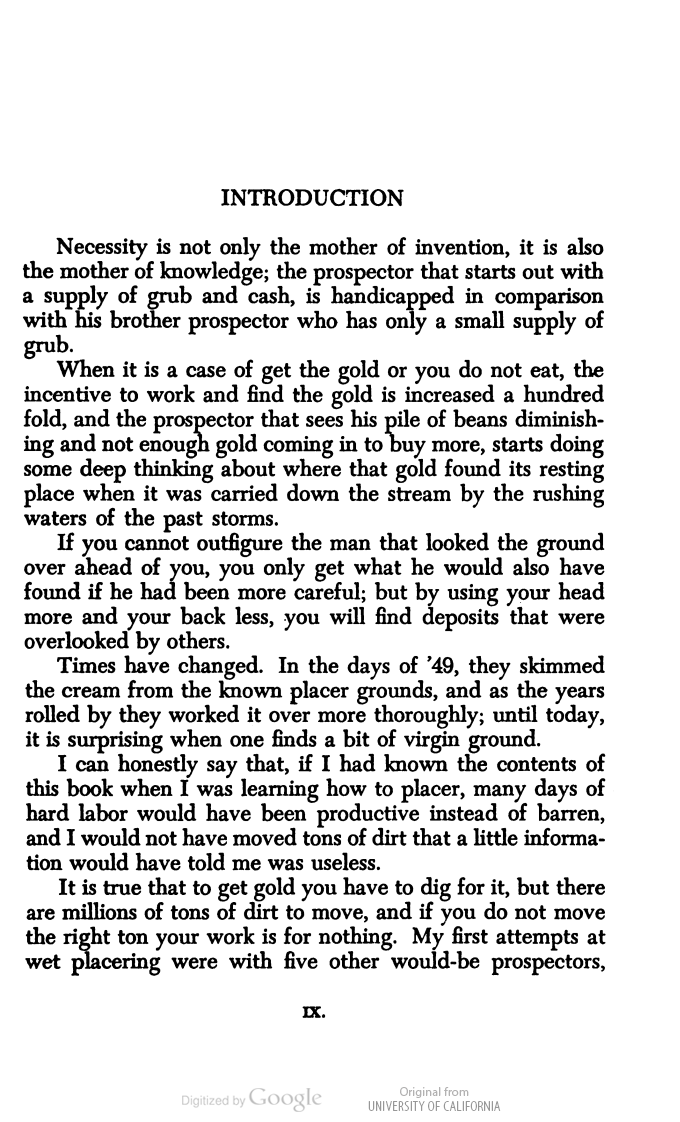
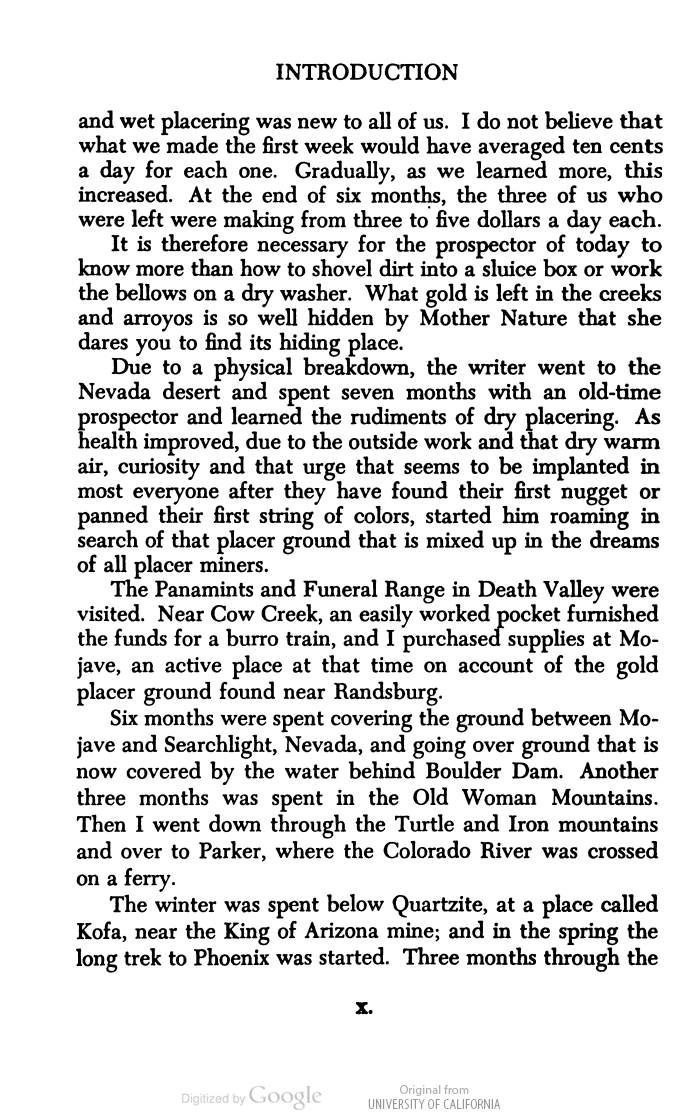
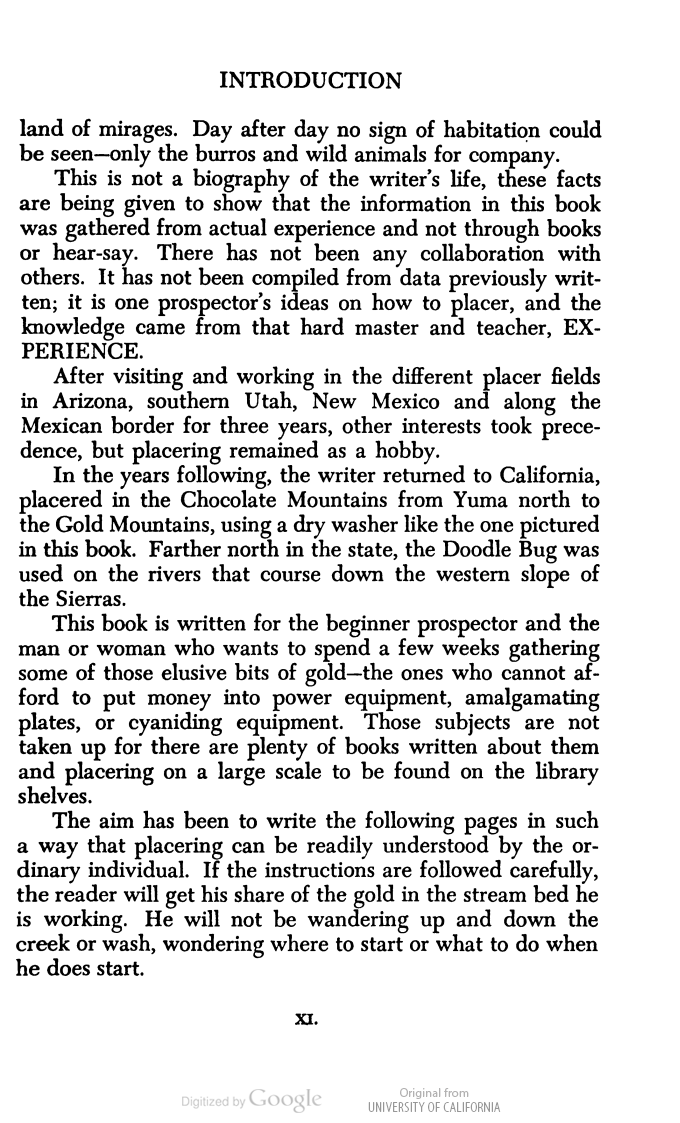
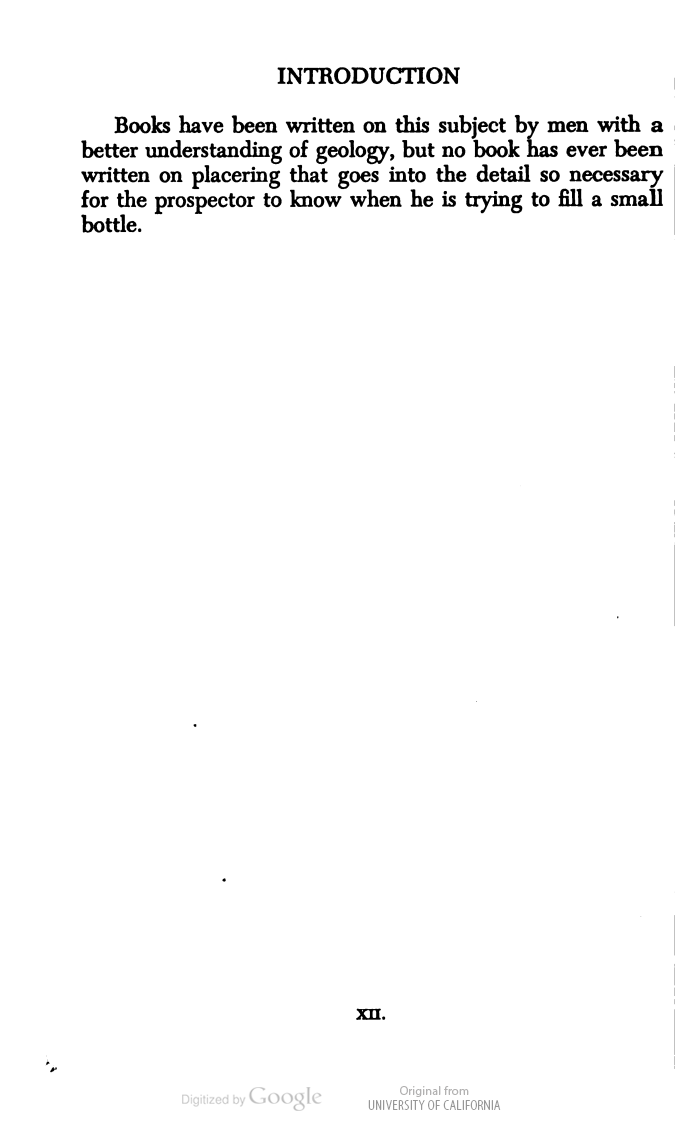
These books describes the technique of test panning these are two classic 1905 short story by Jack London. & Gold in placer ; how to find it. If your just starting out these are the type of books you just need to read. Sure Utube is good but there is also a big trap there for young players. So to speak.
http://www.jacklondons.net/goldcanyon.html
http://babel.hathitrust.org/cgi/pt?id=uc1.$b316705;view=1up;seq=11
Gold in placer ; how to find it.




mdv
Martin
I very much liked the short story. And to top it off, he filled in his hole - what a good chap. 
G
Guest
Thanks mate yep it is a good yarn. A mate in Alaska sent that link. Cheers
Similar threads
- Replies
- 5
- Views
- 817
- Replies
- 33
- Views
- 8K
- Replies
- 2
- Views
- 1K


